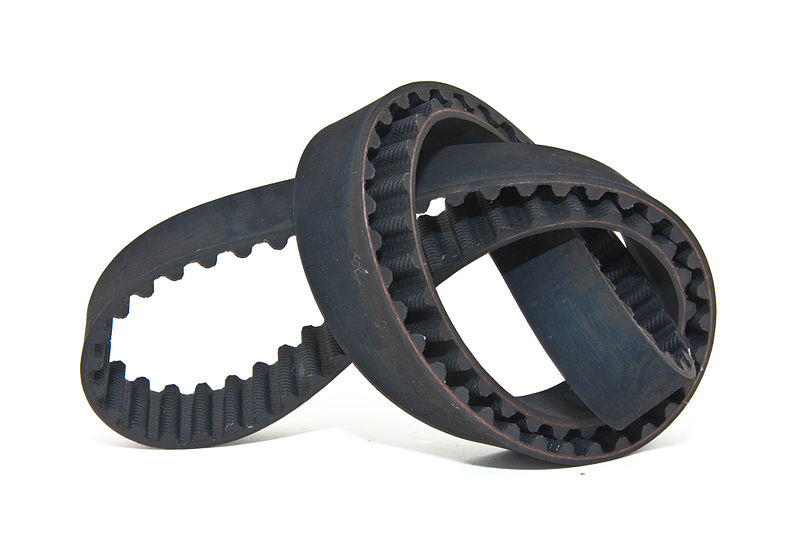A timing belt is one of the most important parts of a car that makes the camshafts and the crankshafts work in collaboration, ultimately keeping the engine running. The crankshaft moves the pistons which in turn helps the power and intake cycles, whereas the camshaft takes care of the valves that allow fuel entry. A timing belt allows both to work in sync with each other. As it precisely times the opening and closing of the valves with the help of the pistons, the name is apt – timing belt. It also runs the oil pump, water pump, and injection pump. However, not all cars have a timing belt, some might see a comeback of the timing chain which was used till the early 80s.
Many timing belts are made of synthetic rubber. For better strength and to reduce stretching, nylon and fiberglass are added. But new cars use chains instead of belts as they are more durable.
It is easy to get confused between a timing belt and a serpentine belt. There are some similarities but they are not the same. If a serpentine belt breaks down, it won’t affect the ability of a car, which is completely opposite in the case of a timing belt. The tearing out of the latter can cause serious issues. Hence, every car manual has detailed information about the service and replacement of a timing belt.

When To Replace The Timing Belt
When to replace the timing belt and how much will it cost will depend on the car’s model and condition. Usually, it is recommended to change the belt between 60,000 to 100,000 miles. Also, if you happen to replace the water pump, it is recommended to get the timing belt changed as well and vice-versa.
Unfortunately, there are no particular signs which indicate the wearing out of the timing belt. However, your car might show some symptoms:
- Loss of power
- Poor fuel economy
- Misfiring and engine vibration
- Maybe timing belt noise
- The belt tensioner may fail
- A pulley may wear out
Moreover, when the timing belt starts to peel off, shows cracks, is softening or hardening, or has oil or water contamination, it is time to replace the belt.
If you wish to check the condition of your belt – press your fingernail against its back. If the impression is embossed, your belt can work for some more time. But if the belt has hardened, it will not allow the impression to be seen. Replacement is required immediately. Do not wait for the belt to break.
When a timing belt of an interference engine breaks, it causes damage to the valves and piston which might have gravely mutilated the engine. On the other hand, with a non-interference engine, a broken timing belt shuts down the engine completely. Without replacing it, the car won’t start.
If your car has a chain instead of a belt, replacement is not required unless very necessary as the latter is a maintenance-free unit.
How To Replace A Timing Belt?
If you have the right tools and skills, replacing a timing belt isn’t a difficult task. The harder parts could be the removal of the main engine pulley and setting the accurate timing along with the new belt adjustment. The car manual has all the details which can help you in the replacement process.
Tools Required –
- Belt tension gauge
- Tensioner pulley and adjuster
- Pulley tool handle
Once you have the tools and the repair manual, you are ready for the work.
The first step is to remove the timing belt –
- Disconnect and keep away the negative battery cable
- Remove the alternator belt
- Remove the timing belt cover after taking off the accessory belts, hoses, or any other components covering it (Some cars may not have a timing belt cover)
- You might also have to remove the cooling fan, power steering, or alternator
- When the cover is removed, check the sensors, accessories, or wires
- Align the timing marks visible on the camshaft and crankshaft sprockets
- The belt tensioner pulley will have the adjustment bolt – Slowly, loosen it or remove it if required
- Remove the bolts or screws which hold the timing cover
- Now, remove the belt off the crankshaft sprocket
- Remove the crankshaft pulley
- Now, remove the timing belt from the vehicle
Install the new timing belt – alignment of the crankshaft and camshaft is very important when you install the timing belt. Check if the new belt is of the same length and width, and has the same tooth configuration as the old one.
- Position the belt around the crankshaft sprocket
- Install the crankshaft pulley
- Align the crankshaft sprocket and pulley with the marks on the engine
- Align the camshaft sprocket and the cylinder head
- Thread the timing belt around the camshaft sprocket
- Move the tensioner into the belt to apply pressure
- Set proper tension
- Reinstall the sensors or brackets you might have removed
- Reinstall the timing belt cover
- Reinstall the accessories you removed
- Connect the negative battery cable to the battery
- Start the engine to check if the belt is working
Yes, replacing the timing belt is an extremely complicated task, but you can seek help from experts if you aren’t ready to do it all by yourself. Do not wait for your engine to stop in the middle of the road. Keep a check on the timing belt and replace it when required.
For more information about automotive spare parts such as timing belts, please call us at +91 98 25063530. You could also fill out our online form for more details.
Also Read:
